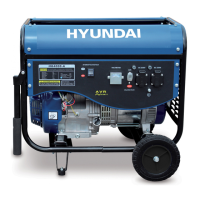
Do you have a question about the Hyundai HG4000-A and is the answer not in the manual?
| Brand | Hyundai |
|---|---|
| Model | HG4000-A |
| Category | Portable Generator |
| Language | English |
Essential safety warnings for operation, refueling, and environmental hazards like toxic exhaust gases.
Operator responsibilities, protective gear, vigilance, and safe operating distances for generator use.
Specific safety advice for non-professional users, including children, fuel handling, and exhaust gas ventilation.
Guidelines for safe refueling, fuel storage, and handling spills to prevent fire and exposure risks.
Safe connection practices, grounding, extension cords, and building electrical system integration for preventing shock.
Ensuring connected devices match generator voltage and frequency specifications to prevent damage.
Proper procedures for disposing of residual fluids like fuel and oil to meet local environmental requirements.
Visual guide to important safety symbols used on the product and in the manual, explaining their meanings.
Important warnings displayed on the product, covering fuel leaks, hot components, and maintenance procedures.
Detailed process for cleaning and servicing the air filter element, including recommended frequency and cleaning methods.
Identification of key generator parts such as the Motor Switch, Fuel Valve, Circuit Breaker, and AC Outlets.
Details from the generator's nameplate, including model, power, voltage, and manufacturing information.
Step-by-step guide for attaching the wheels to the generator frame using axes, washers, and pins.
Instructions for installing the foot pads, including washers and screws, to stabilize the generator.
Procedure for attaching the handles to the generator, involving locating holes and fixing with screws and nuts.
How to use the engine switch for starting, stopping, and running the generator, including key operation.
Method for starting the engine using the recoil starter, emphasizing gentle return to prevent damage.
Function and operation of the fuel valve, controlling fuel flow from the tank to the carburetor.
How to use the choke lever or rod to enrich the fuel mixture for starting a cold engine.
Role of the circuit breaker in protecting against short circuits and overloads, and how to reset it.
Information on the generator ground terminal, its connections, and the need for consulting an electrician for proper grounding.
Explanation of the oil alert system's function to prevent engine damage due to low oil level, including automatic shutdown.
Guidance on connecting the generator to a building's electrical system, emphasizing qualified electrician use.
Details on generator grounding to prevent shock, connecting frame to ground sources, and system ground configuration.
Precautions for connecting appliances, checking their condition, and ensuring load capacity is not exceeded.
Steps for operating the generator in AC mode: starting engine, switching breaker, plugging in appliances.
Effects of high altitude on performance and fuel mixture, and potential modifications for optimal operation.
Importance of checking engine oil level before each use to ensure proper performance and engine life.
Guidelines on checking fuel level, refueling procedures, and recommended fuel types for optimal engine performance.
Information on using oxygenated fuels, ethanol content, and potential issues with gasoline containing high ethanol levels.
Detailed steps for starting the engine, including setting the circuit breaker, fuel valve, choke, and using the starter.
Procedures for stopping the engine safely in both normal use and emergency situations.
A table outlining periodic service intervals and tasks for engine oil, air cleaner, spark plug, and other components.
Information about the included tool kit and its importance for performing owner maintenance procedures.
Step-by-step instructions for draining old oil, replacing the plug, and refilling with new oil.
Detailed process for cleaning and servicing the air filter element, including washing and oiling.
Guide to inspecting, cleaning, gapping, and replacing the spark plug for optimal engine performance.
Precautions for safely transporting the generator, including securing the engine switch, fuel valve, and keeping it level.
Recommended service procedures for storing the generator for extended periods to prevent hard starting.
Detailed steps for preparing the generator for storage, including draining fuel, changing oil, and lubricating the cylinder.
Troubleshooting guide for common engine starting problems, covering fuel, oil, and spark issues.
Troubleshooting steps when there is no electricity at the AC receptacles, checking the circuit breaker and appliances.
The electrical schematic showing the generator's internal wiring, components, and connections with color codes.
Detailed technical data for the engine and generator set, including model, power, dimensions, and operating limits.
Official declaration of conformity to European directives and standards, including model, serial number, and manufacturer details.
Details of the product warranty period, coverage, exclusions, and how to claim service.
Instructions on how to identify and order spare parts, including necessary information and contact methods.
Steps to follow if the machine breaks down, including what to do when buying from a store or website.
A comprehensive list of conditions and damages that are not covered by the product's warranty.